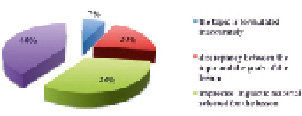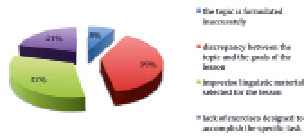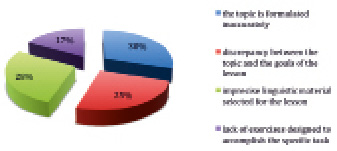The practical training of Special Education students is an integral part of the learning process in all accredited institutions of higher education that admit students in this field. The Faculty of Education at Trakia University in the city of Stara Zagora has been admitting students and training specialists to work with children and students with special educational needs since its founding in 2002. The necessary conditions to train such students have been established since the very beginning. A lot of positive experience has been accumulated and summarized over the years. At the same time, the demands of our society concerning the quality of student education, and their practical training in particular, have been on the increase. The higher requirements stem mostly from: the continuous in-depth study of the specific characteristics in the development of children and students with special needs and the findings concerning their significant and largely untapped potential, the improved options for comparing the outcomes of their training, rehabilitation and socialization in different countries, and the development of special education and its increasing integration with other scientific fields. In order to meet the rising demands of our society, the practical training of students needs to be explored further, analyzing its current state and the perspectives for the future. Proof of this can be found in the development and regular updates of the instructions for the organization and implementation of different types of practice – classroom observation, ongoing and pre-graduation teaching practicum, the inclusion of specific requirements in these instructions concerning the organization, form and content of the activity, the control and assessment process, the acquisition of key competences, etc. The respective facilities for practical training are also expanding. The selection of structures to be used for this purpose and on-site teachers and speech therapists is improving. To summarize, the focus falls on all aspects of this exceedingly complex process and the optimal utilization of all available resources. Practical training is becoming a question of present interest and an increasingly important part of specialist theory and research. Proof of the latter can be found in the publications of authors like N.M. Nazarova et al [1], Gadzhalova – Lefterova D. [2], Tsvetkova M. [3], Radulov Vl. [4], Trashliev R., E. Evgenieva [5], Karagyozov Iv., V. Katsarska [6], Katsarska V., Zh. Stoykova [7] and many others. Their works explore not only the present state of practical training, but also provide evidence for the need to discuss this topic within a new conceptual framework requiring the inclusion of as yet unused resources – team-based practicum management, including assistant and habilitated instructors with high level training and experience, regular discussions of the observed lessons conducted by on-site teachers and students, and summarization of the results – in some cases they are “repeated” and in others they appear “unreplicable» [5], establishment of student support structures for critical situations [7] etc. This as yet underutilized resource aims to improve the results of the students’ practice and encourage them to transform successfully their theoretical knowledge into practical skills, and, last but not least, it has a positive impact on the students’ motivation to pursue the complex and difficult, but socially significant profession of the special needs teacher and speech therapist.
The present study is also aimed at enhancing the teaching practice and improving the results of the students in the field of Special Education.
For that purpose, we analyzed 64 lessons and sessions, presented by students in the aforementioned field, conducted over the last five years [2012 – 2017] at the Special Needs School in Stara Zagora, the Resource Center, as well as the speech and language therapy offices at the Fourth, Fifth, Sixth and Ninth schools in the city.
Even though the two authors of the present research collected lesson plans and speech and language therapy session outlines over different timeframes, general findings and conclusions are presented below.
The types of outlines analyzed are presented in Table No.1.
Table 1
Analyzed sessions
|
Type of analyzed session |
Number of sessions |
|
Classroom lessons |
22 |
|
Sessions at the Resource Center |
17 |
|
Sessions at speech and language therapy offices |
25 |
|
Total: |
64 |
As seen in the table above, the types of analyzed sessions are not equal in number. Even though the differences in this respect are relatively minor, the three types of outlines will be analyzed separately based on their specific characteristics.
The more common mistakes have been identified and described for each type of outline, and they appear similar in practical terms. This can be explained with the students’ difficulties in specifying precisely the topics, goals and tasks, as well as in selecting the linguistic materials and exercises for solving a particular task that are the most suitable for the children’s needs.
Our observations, informal conversations with the students and the results of the analysis show that they generally subscribe to the idea that practical training is crucial for their future professional career. Our direct discussions with them, however, revealed that they want an increase in the number of hours dedicated to practical training, especially concerning their pre-graduation practicum.
All analyzed outlines were developed independently by the students, submitted in print and well structured.
The analysis of the outlines shows that they contain all the important structural elements – session topic, principles, goals, tasks, linguistic material, demonstration tools. The plan for the course and direction of the specific sessions is also provided. The necessary demonstration tools are available – toys, pictures, models, etc. This can be viewed as evidence of the well-developed skills of the university students to plan and prepare specific lessons and speech and language therapy sessions.
The observations and the analysis of the detailed course of the session, described by the students, also show a desire to create a pleasant and stimulating environment, to establish successful contact and communication with the children, as well as to properly select the linguistic and nonlinguistic means [gestures, fingertalk, body language, etc.] that meet the children’s needs.
The positive aspects described above lend credence to the claim that in general students demonstrate adequate preparedness for working with children with special educational needs.
We appreciate the positive aspects of the planning the students performed and believe that on the one hand, they demonstrate a relatively high level of preparation, and on the other hand, what they have already achieved can serve as a successful basis for improving their skill in planning different types of sessions designed for children with special educational needs.
The analysis of the outlines presented by the students also showed some mistakes. The most common mistakes have been identified and described for each type of outline, and they appear similar in practical terms. This can be explained with the students’ difficulties in specifying precisely the topics, goals and tasks, as well as in selecting the linguistic material and exercises for solving a particular task that are the most suitable for the children’s needs.
Figure No.1 below presents the most common mistakes made in the development of lesson plans for students at the Special Needs School in Stara Zagora.
It is immediately obvious that the lowest percentage of mistakes are those connected with the formulation of the topic. This is probably due to the fact that the topics had already been formulated in the teachers’ respective programs and syllabi. The few mistakes might be due to the students’ lack of experience in adapting certain topics to the needs of children with a more serious form of intellectual disability [moderate or moderate to severe]. For example, the topic of one lesson was formulated as “Animals”, while the lesson plan only covered the “Domestic Animals” topic.
Students find it more difficult to achieve consistency between the topic and the goals of the planned lesson. One examples of this is the following: The topic of the lesson plan is “Fruits”, while the goal derived from it is “Fruits that grow in our country”. This transforms the goal into a specification of the topic. In agreement with the ideas of Prof. R. Trashliev and E. Evgenieva [5] that preparation is an ongoing process for teachers in both mainstream and special needs schools, we firmly believe that the students who made mistakes will be able to overcome them and perform just as well as the other 80 % who achieved consistency between goals and topic, as long as they are they receive the proper encouragement and support from the teaching staff.
What is more troubling is the fact that approximately one-third of the analyzed lesson outlines included the use of linguistic material that was not precisely selected for the needs of students with intellectual disabilities. It goes without saying that they need to learn new words and phrases within the context of the topic covered by the lesson, but it is not acceptable to use vocabulary with low communication value for this specific category of students. There is a good reason why specialists place so much emphasis on the practically oriented training for these children. Understanding expressions [under the aforementioned topic] such as “People have cultivated this fruit”, “hybrid seed”, “fiber-rich” is a difficult task for primary school children with special needs. Such expressions can be replaced with others that would be less problematic for the children to grasp, or in some cases, they can be completely omitted. As they go on to practice the complex and difficult teaching profession, most of the university students will learn on their own to avoid such mistakes, but it would be much easier to have the teaching staff at the school help them to prevent these problems in the first place.

Fig. 1. Common mistakes in the lesson plans developed for students at the special needs school

Fig. 2. Common mistakes at the Resource Center
This also applies to another type of mistake – the lack of exercises for the accomplishment of a specific task. For instance, in one case the formulated task was to identify and specify the colors and shapes of different types of fruit, but no exercise connected with this task was included in the planned activities for the lesson.
Similar mistakes were found in the outlines for sessions with special needs children at the Resource Center. They are depicted in Fig. No. 2.
These outlines are also characterized by fewer mistakes related to the topic formulation. In this respect, there are minimal differences in comparison with the situation at the special needs school [one percent], but they still exist. The explanation for the relatively low number of mistakes of this type is similar to the one for the session plans for children at the special needs school – it is the presence of topics already developed by the resource teachers.
The second most common type of mistake relates to the planning of exercises corresponding to the specific task to be performed for the purpose of achieving the main goal of the session. In comparison with the mistakes of the same type made in the planning of lessons at the special needs school, their frequency is approximately half of what we saw at this institution, but they still should not be overlooked. Evidence supporting that last statement can be found in the lack of exercises that correspond to tasks with a significant corrective function.
The imprecise linguistic material constitutes the majority of the mistakes made at the Resource Center. The most common subtype is the use of words and expressions connected with the topic that are characterized by low communication value for the children, as well as ones they find difficult to understand. Some of the important functions of the Resource Center are to expand the active vocabulary of the children and to enable understanding of the lesson content. Bearing this in mind, it should be obvious how important it is to focus on avoiding such errors.
A surprisingly large proportion of the mistakes are connected with inconsistency between the topic and the goals of the session. This observation can be discussed not only in the context of the individual planned session, but also from the perspective of the entire series of sessions covering a particular topic. To some degree, students still lack the necessary skills to envision the whole cycle of sessions on a specific topic and thus to plan the respective goals and tasks for each of them. It would very useful to observe their skill level in this respect at different stages of their training. The results would probably lead to the development of different forms and means of training that would produce better results in theoretical and practical terms.
The session plans developed for working with children and students at the speech and language therapist’s office are also characterized by certain mistakes [Fig. No.3].
The percentage of mistakes concerning the topic formulation is much higher compared to the other two categories of outlines discussed above. In almost one-third of the cases, the topic is inaccurately described. Often it simply reflects the goal of the session. Most commonly, such mistakes can be found in the sessions developed for improving the children’s pronunciation. A typical example of this type of mistake is formulating the topic of the session as “Automation of the “s” sound”.

Fig. 3. Common mistakes at the speech and language therapy office
The therapy session plans are often plagued by inconsistency between the primary goal and the topic of the session. In a session on the aforementioned topic [«Automation of the “s” sound»], the main goal is formulated as follows: “Correct pronunciation of the “s” sound”. The discrepancy is obvious and the topic and goal cannot be distinguished from one another.
It is a common occurrence to find imprecisely selected linguistic material as part of a session plan. This type of mistake usually relates to the low communication value of the linguistic material chosen for the young children. There are many examples of this. For instance, in a session outline for the correction of the “sh” sound in young children, in addition to appropriate and common vocabulary such as the Bulgarian words for “neck”, “hand”, “sew”, “chocolate” and others, there are less common and useful words like „furcoat”, “overshoes”, “mill-wright”, a colloquial word that means “doing the housework”, etc.
In one-quarter of the session outlines for the speech and language therapy office, there are mistakes related to the lack of exercises for accomplishing the specific task. A typical example of this is the absence of exercises corresponding to the tasks of improving the auditory gnosis, the language-related visual perception skills of children with impaired hearing, the fine motor movement, the letter-sound knowledge, etc.
The analysis of the mistakes and the observations in general point to the need for improving both the theoretical and the practical training of the university students.
With regard to theoretical knowledge, it is important to emphasize and explain more clearly the meaning of the goals and tasks of each type of session, to clarify to the students their interrelationship and relative individual function, to seek the correlation between them, as well as between the place and role of the individual exercises with regard to the general goals and tasks.
It is recommended that such mistakes are discussed during seminar and practical training sessions in order to help the students understand why they should not be included in lesson plans and outlines and how to avoid them in their practice.
We agree with Zh. Stoykova and V. Katasrka [7], who espouse the idea that a model needs to be implemented to include experienced special needs teachers and psychologists as part of the student practicum supervisor team. The existing standards of higher education involve these specialists for the most part only in the classroom training of university students
Resources for improving the skills of the student body in the planning and conduct of practical sessions can be found in the students themselves, as well as in their professors and instructors. It is simply a matter of placing the emphasis on this extremely important question and seeking specific forms, content and methods to solve the problem successfully in order to meet the increased demands of society regarding student training, rehabilitation and speech and language therapy. The positive attitude of the university students towards their practical training can serve as an excellent foundation for this undertaking, along with their understanding of its crucial importance for their future professional career and the relatively high level of preparedness they demonstrate when it comes to working with special needs children.
And last but not least, it is important to point out the students’ wish for more hours of practical training, which they expressed on many different occasions. It is imperative to fulfil their desire just based on the presence of many different subgroups of special needs children and the need for specific activities tailored to their needs and the individual characteristics of each child.
Библиографическая ссылка
Todorova-Markova Gergana Borislavova PRACTICAL TRAINING OF STUDENTS IN THE FIELD OF SPECIAL EDUCATION – ACHIEVEMENTS, DIFFICULTIES AND FUTURE PERSPECTIVES // European Journal of Natural History. 2018. № 6. С. 40-44;URL: https://world-science.ru/ru/article/view?id=33943 (дата обращения: 22.11.2025).

